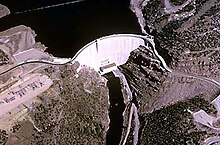Colorado River Storage Project
The project provides hydroelectric power, flood control and water storage for participating states along the upper portion of the Colorado River and its major tributaries.
In order to regulate the flow of the Colorado and ensure compliance with the compact, a study was undertaken that determined a series of dams and reservoirs on the river and its tributaries would be necessary.
A joint effort between the Upper Colorado River Commission, the Bureau of Reclamation and other federal agencies delivered a report with proposed projects to the United States Congress in 1950.
Among the proposed projects was a dam to be constructed on the Green River in Echo Park, in Dinosaur National Monument in Colorado.
Brower, who had not personally visited Glen Canyon prior to the compromise, later lamented the deal, describing it as "the worst mistake of his career" and "'the biggest sin I ever committed'".
The legislation called for the construction of dams, reservoirs and related works at Curecanti in Colorado, Flaming Gorge in Wyoming, Navajo in New Mexico and Glen Canyon in Arizona.
This capacity is released to meet the Colorado River Compact's delivery requirements during periods of low flow in the system.
[1] While the dam is located near Page in northern Arizona, the majority of Lake Powell resides in southern Utah.
Sierra Club director David Brower, who was partially responsible for the location of the dam as part of a compromise, later regretted the decision.
[4] Former Arizona Senator Barry Goldwater, who was a proponent of the dam in the beginning, later recanted his opinion and admitted that he had regretted supporting the project.
Given the importance of the unit to the project as well as its impact as a tourist destination to the region, restoration efforts face significant opposition and there currently exist no plans to cease operations at Glen Canyon.
Completed in 1964, the dam provides water storage and hydroelectric generation, as well as flood control on the Green River, the primary tributary to the Colorado.
A small plant with a capacity of 32 MW was installed in 1983 in conjunction with the city of Farmington to generate local power.
Morrow Point has a generating capacity of 173,334 kilowatts, making it the second most productive dam in the entire Colorado River Storage Project system.
[1] Fruitland Mesa & Savery-Pot Hook Projects were cut by the United States Senate in the Public Works appropriations bill of July 1977.
The Blue Mesa and Navajo Dams, built primarily to function for flood control purposes, have saved approximately $10 million in flood-related costs up to the year 1999.
[18] The project has changed the topography of the river with the heavy loads of silt trapped behind the dams deposited in the upper reaches of the reservoirs.
Invasive species have become dominant in the Delta and the loss of this habitat has had wider implications for marine life in the Gulf of California.








